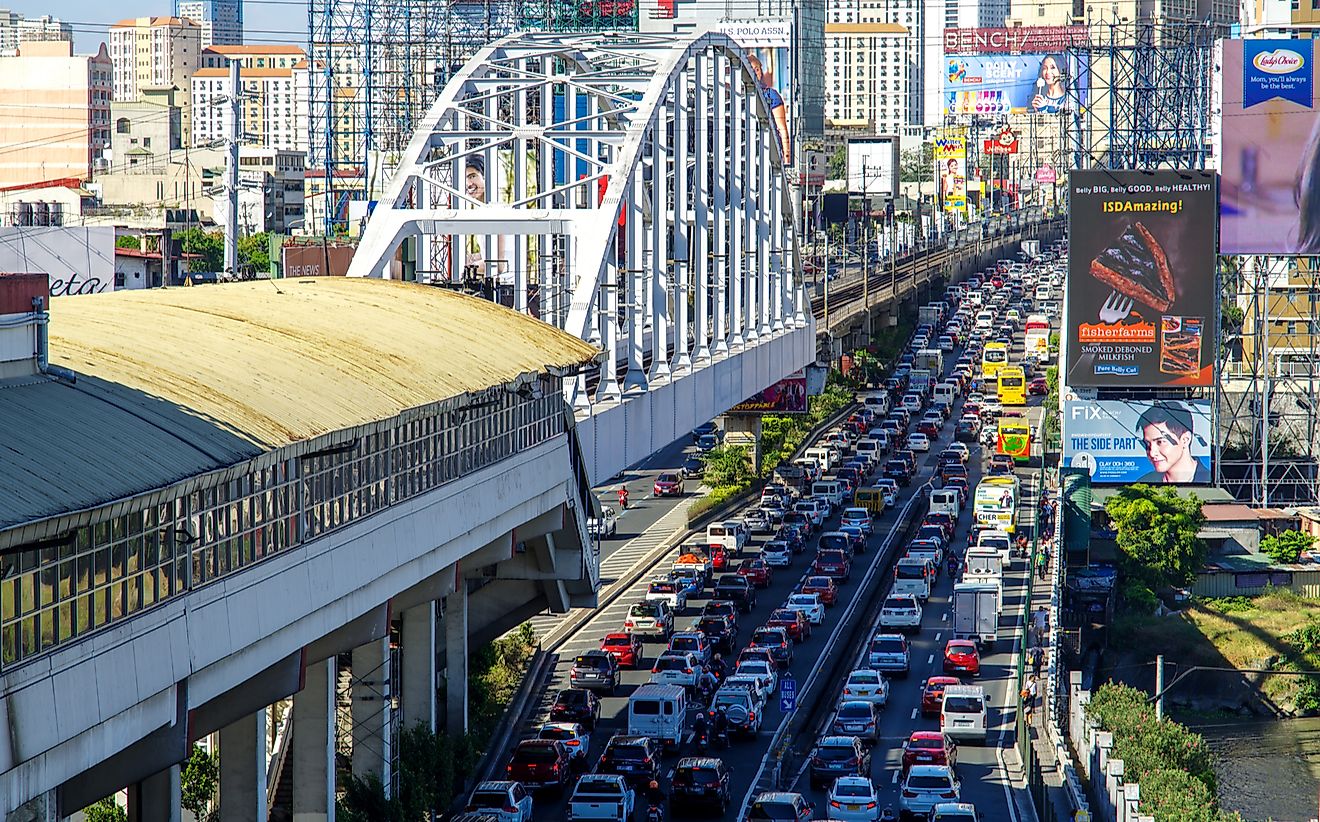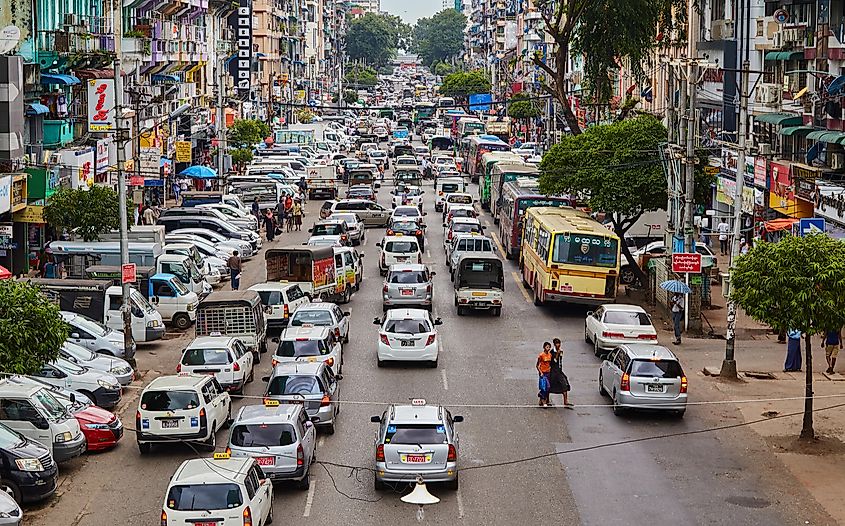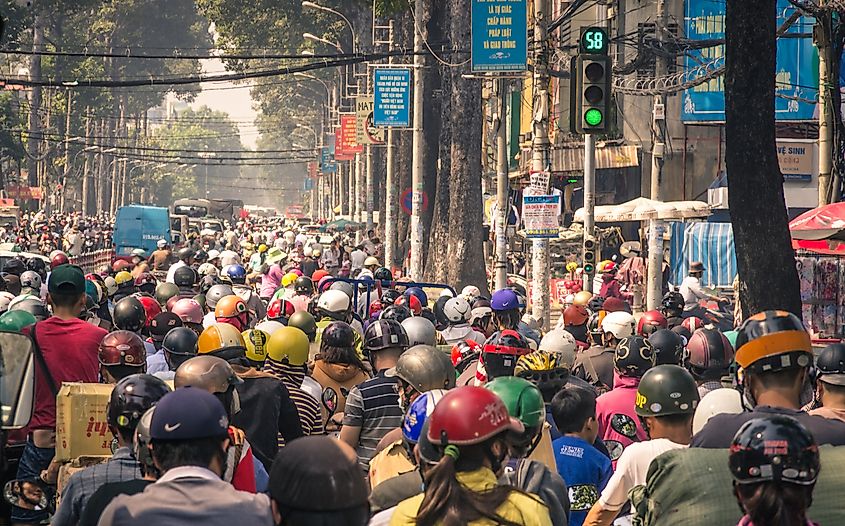The 10 Most Congested Asian Cities

Asia is home to some of the most rapidly developing countries and the fastest-growing cities in the world. The economic growth being witnessed in the region is giving rise to several challenges, including congestion in cities.
A study recently done by the Asian Development Bank identified Manila in the Philippines as the most congested city in the region. Indian cities are the most featured on the list with cities such as Bangalore, Delhi, Kolkata, and Pune listed as having some of the worst traffic gridlocks.
The study utilized satellite imagery to locate the busiest roads in 278 cities in 28 countries and subsequently utilized Google maps data to compare the trip time at off-peak and peak hours. The study found that the average congestion value in the region was 1.24, meaning that it takes 24% more time to travel during peak hours than off-peak hours.
Manila
Manila is ranked as the most congested city in Asia. According to the Asian Development Bank (ADB), the problem is mainly due to a lack of efficient and affordable public transportation. The city has a congestion value of 1.5.
Kuala Lumpur
The city of Kuala Lumpur in Malaysia has a congestion value of 1.40, making it the second most congested city in Asia. The score means that it takes, on average, 40 minutes more to travel during peak hours than off-peak hours. In the last decade, new highways have been constructed across the city to reduce traffic congestion. The highways are, however, poorly designed and contribute to the traffic menace. Most of the highways landing in the city are in areas already congested, such as Jalan Tun Razak, Sungai Besi, and Jalan Kuching. Private highways, most of which were constructed in the last ten years, have been criticized for poor designs.
Yangon

Yangon in Myanmar has the highest population and vehicle densities in the country. The city has a congestion score of 1.38, meaning that it takes 38 minutes more to travel during peak hours compared to off-peak hours. The government is currently planning on constructing overpasses at various intersections along roads with heavy traffic. A significant number of city residents rely on buses for transportation. The country is also looking to improve the YBS passenger buses system, which is controlled by the Yangon Region Transport Authority.
Dhaka

The city of Dhaka in Bangladesh has a congestion score of 1.33, which makes it the fourth-most congested city in Asia. According to a World Bank report, the city loses 3.2 million working hours in traffic congestion, which translated to billions of dollars of lost revenue. The city has an average driving speed of 4.35 miles per hour. If the current traffic trend continues, it is expected that the speed will drop to 2.5 miles per hour. The slow traffic speed represented a massive drop from 10 years ago when the speed was 13 miles per hour. The congested nature of the city is attributed to unplanned urbanization and a disorganized traffic system. The country is currently looking to improve the city by building an embankment on the Balu River to reduce flooding, developing public transit and transport links, and creating a world-class business district.
Bangalore
Bangalore is the fifth most congested city in Asia and the most congested city in India. The city has a congestion score of 1.30, meaning that it takes 30 minutes more to travel during peak hours than during off-peak hours. In 2005, the speed of traffic in the city was 22 miles per hour, but by 2014, the speed had declined to 5.7 miles per hour. During peak times, the speed is usually about 2.5 to 3 miles per hour. According to studies of the city, the average city citizen loses 240 hours stuck in traffic every year. It is also estimated that the city loses 950 million dollars due to congestion each year.
Hanoi
Hanoi in Vietnam has a congestion score of 1.30. The city loses up to 1.2 billion US dollars due to traffic congestion. The traffic jams are also thought to be behind the high levels of air pollution in the city. New apartment buildings in the heart of the city have been blamed for the congestion, especially during peak hours. The government is currently looking to improve infrastructure to ease traffic in densely populated areas. The city's traffic safety committee has also undertaken several measures, including adjusting traffic lights and installing warning signs to improve the situation.
Kolkata
Kolkata is ranked as the second most congested city in India and the seventh in Asia with a congestion score of 1.28. Rapid urbanization has led to an increased demand for mobility. Public transport has, however, been unable to satisfy the transportation needs of the population, which has consequently led to a rise in vehicle ownership. The traffic situation in Kolkata is made worse by the fact that the road space in the city is only 6%, which is quite low compared to cities such as Mumbai.
Delhi
Delhi has a congestion score of 1.27, making it the eighth-most congested city in Asia. Studies of the city have revealed that the city experiences low traffic speed, weekends with higher congestion, near disappearance of non-peak hours, and higher air pollution, particularly during peak hours. Pollution caused by vehicles stuck in traffic is undercutting efforts to control emissions in the city to improve the quality of life. Experts believe that congestion in the city can be alleviated by developing affordable, comfortable, and reliable metro and bus transport services, implementing the proposed parking policy, and encouraging cycling and walking culture.
Pune
Pune has a congestion score of 1.26, making it the fourth most congested city in India. The city aspires to become a global urban center that is safe, livable, with functional connectivity. Studies on the city, however, tell a different story with the yearly Environmental Status Report showing that the city is witnessing a significant rise in the levels of noise and air pollution. The city suffers from inadequate mass transportation systems and infrastructure to cope with the traffic. The city is set to become one of the largest cities in India, with the incorporation of 34 villages in the surrounding areas into the city. The government is looking to improve traffic policing and infrastructure to remedy the traffic situation. The city is also looking forward to joining the Metro City club.
Ho Chi Minh City

The Vietnamese city of Ho Chi Minh has a congestion score of 1.24. The city loses approximately 6 billion dollars every year due to traffic congestion. The city has experienced rapid urbanization over the past years with the mushrooming of tall buildings across the city. The country is currently looking to improve the flow of traffic by building more roads and bridges. Land set aside for roads is likely to increase to 12.2% in 2020 from 10.01% in 2019. The public transportation system is also expected to accommodate higher passenger numbers going into the future.
The 10 Most Congested Asian Cities
| Rank | City | Index Score for most congested Asian cities (1=24% longer travel time/peak hours) |
|---|---|---|
| 1 | Manila | 1.51 |
| 2 | Kuala Lumpur | 1.40 |
| 3 | Yangon | 1.38 |
| 4 | Dhaka | 1.33 |
| 5 | Bangalore | 1.30 |
| 6 | Hanoi | 1.30 |
| 7 | Kolkata | 1.28 |
| 8 | Delhi | 1.27 |
| 9 | Pune | 1.26 |
| 10 | Ho Chi Minh City | 1.24 |











